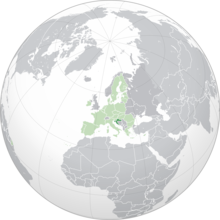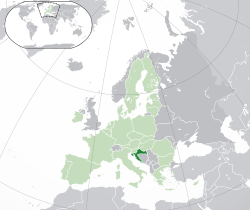
Back Хорватиа Abkhazian Kroasia ACE Хорватие ADY Kroasië Afrikaans Kroatien ALS ክሮኤሽያ Amharic Croatia AMI Croacia AN Croatia ANG Kuresha ANN
Republic of Croatia | |
|---|---|
| Anthem: "Lijepa naša domovino" ("Our Beautiful Homeland") | |
Location of Croatia (dark green) – in Europe (green & dark grey) | |
| Capital and largest city | Zagreb 45°48′47″N 15°58′39″E / 45.81306°N 15.97750°E |
| Official languages | Croatian[b] |
| Writing system | Latin[c] |
| Ethnic groups (2021) | |
| Religion (2021) |
|
| Demonym(s) | |
| Government | Unitary parliamentary republic |
| Zoran Milanović | |
| Andrej Plenković | |
| Gordan Jandroković | |
| Legislature | Sabor |
| Establishment history | |
• Duchy | 7th century |
• Kingdom | 925 |
| 1102 | |
• Joined Habsburg Monarchy | 1 January 1527 |
• Secession from Austria-Hungary | 29 October 1918 |
| 4 December 1918 | |
| 9 May 1944 | |
| 25 June 1991 | |
| Area | |
• Total | 56,594 km2 (21,851 sq mi) (124th) |
• Water (%) | 1.09 |
| Population | |
• 2023 estimate | |
• 2021 census | |
• Density | 68.4/km2 (177.2/sq mi) (152nd) |
| GDP (PPP) | 2025 estimate |
• Total | |
• Per capita | |
| GDP (nominal) | 2025 estimate |
• Total | |
• Per capita | |
| Gini (2023) | low inequality |
| HDI (2022) | very high (39th) |
| Currency | Euro (€) (EUR) |
| Time zone | UTC+1 (CET) |
• Summer (DST) | UTC+2 (CEST) |
| Calling code | +385 |
| ISO 3166 code | HR |
| Internet TLD | |
Croatia,[d] officially the Republic of Croatia[e] is a country in Central and Southeast Europe, on the coast of the Adriatic Sea. It borders Slovenia to the northwest, Hungary to the northeast, Serbia to the east, Bosnia and Herzegovina and Montenegro to the southeast, and shares a maritime border with Italy to the west. Its capital and largest city, Zagreb, forms one of the country's primary subdivisions, with twenty counties. Other major urban centers include Split, Rijeka and Osijek. The country spans 56,594 square kilometres (21,851 square miles), and has a population of nearly 3.9 million.
The Croats arrived in modern-day Croatia in the late 6th century, then part of Roman Illyria. By the 7th century, they had organized the territory into two duchies. Croatia was first internationally recognized as independent on 7 June 879 during the reign of Duke Branimir. Tomislav became the first king by 925, elevating Croatia to the status of a kingdom. During the succession crisis after the Trpimirović dynasty ended, Croatia entered a personal union with Hungary in 1102. In 1527, faced with Ottoman conquest, the Croatian Parliament elected Ferdinand I of Austria to the Croatian throne. In October 1918, the State of Slovenes, Croats, and Serbs, independent from the Habsburg Empire, was proclaimed in Zagreb, and in December 1918, it merged into the Kingdom of Yugoslavia. Following the Axis invasion of Yugoslavia in April 1941, most of Croatia was incorporated into a Nazi-installed puppet state, the Independent State of Croatia. A resistance movement led to the creation of the Socialist Republic of Croatia, which after the war became a founding member and constituent of the Socialist Federal Republic of Yugoslavia. On 25 June 1991, Croatia declared independence, and the War of Independence was successfully fought over the next four years.
Croatia is a republic and has a parliamentary system. It is a member of the European Union, the Eurozone, the Schengen Area, NATO, the United Nations, the Council of Europe, the OSCE, the World Trade Organization, a founding member of the Union for the Mediterranean, and is currently in the process of joining the OECD. An active participant in United Nations peacekeeping, Croatia contributed troops to the International Security Assistance Force and was elected to fill a non-permanent seat on the United Nations Security Council in the 2008–2009 term for the first time.
Croatia is a developed country with an advanced high-income economy.[8] Service, industrial sectors, and agriculture dominate the economy. Tourism is a significant source of revenue for the country, with nearly 20 million tourist arrivals as of 2019.[9][10][11] Since the 2000s, the Croatian government has heavily invested in infrastructure, especially transport routes and facilities along the Pan-European corridors. Croatia has also positioned itself as a regional energy leader in the early 2020s and is contributing to the diversification of Europe's energy supply via its floating liquefied natural gas import terminal off Krk island, LNG Hrvatska.[12] Croatia provides social security, universal health care, and tuition-free primary and secondary education while supporting culture through public institutions and corporate investments in media and publishing.
Cite error: There are <ref group=lower-alpha> tags or {{efn}} templates on this page, but the references will not show without a {{reflist|group=lower-alpha}} template or {{notelist}} template (see the help page).
- ^ "Share of Croats in Croatia increases as census results published". 22 September 2022.
- ^ "POPULATION ESTIMATE OF THE REPUBLIC OF CROATIA, 2023". podaci.dzs.hr. 8 September 2023. Retrieved 1 July 2024.
- ^ "Population by Towns/Municipalities" (xlsx). Census of Population, Households and Dwellings in 2021. Zagreb: Croatian Bureau of Statistics. 2022.
- ^ a b c d "World Economic Outlook Database, October 2024 Edition. (Croatia)". www.imf.org. International Monetary Fund. 22 October 2024. Retrieved 22 October 2024.
- ^ "Gini coefficient of equivalised disposable income – EU-SILC survey". ec.europa.eu. Eurostat. Retrieved 3 September 2023.
- ^ "Human Development Report 2023/2024" (PDF). United Nations Development Programme. 14 March 2024. Retrieved 19 March 2024.
- ^ "Hrvatski sabor – Povijest". Archived from the original on 6 March 2018. Retrieved 10 March 2018.
- ^ "IMF World Economic Outlook". Retrieved 14 April 2023.
- ^ "Croatia tourist arrivals 2022". Statista. Retrieved 5 November 2023.
- ^ "International tourism, The World Bank". Retrieved 14 April 2023.
- ^ "Condé Nast Traveler, Top Countries in the World". Retrieved 14 April 2023.
- ^ "U.S. Department of State factsheet". Retrieved 24 April 2023.



